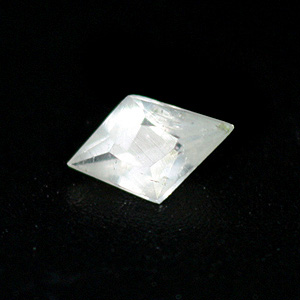Colemanite

Colemanite
(From California, USA. 0.19 carat; 6.0 x 3.9 x 2.2mm)
Image © supplied by Freakingcat Gems
Colemanite is a borate mineral that was first discovered in 1884 by William Tell Coleman, the owner of Death Valley, California, USA. It was in Furnace Creek, Death Valley that the crystals of Colemanite were first found. Furnace Creek was formerly central to Death Valley mining and operations for the Pacific Coast Borax Company. [1]
According to Wikipedia, the chemical formula for Colemanite is (CaB3O4(OH)3·H2O) [2] - however Mindat has the formula as Ca2B6O11•5(H2O). [3]
Colemanite crystals hence derive their name from the discoverer, in his honor. Their rarity is what makes them popular with mineral collectors, and they have occasionally been faceted into gemstones.
Colemanite is extremely rare and found in very few localities. Colemanite has been found in numerous mines in Death Valley, California. Trace amounts of gemstone quality Colemanite are also found in Boron Valley and Yermo Valley in California. Deposits of Colemanite crystals have now been discovered in several other locations, typically dry lakebeds of arid / desert regions including Panderma in Turkey, Serbia, Mexico, Kazakhstan, Greece, Canada, Iran and Argentina. [3] The largest known Colemanite crystal was found in Death Valley, California.
Colemanite is what is known as a secondary mineral. This means that it was not one of the minerals deposited when the landscape originally formed, but was deposited afterwards. In arid regions where the element boron is abundant, runoff from the mountains fills intermittent lakes known as playas. In the dry season these lakes evaporate, leaving high concentrations of minerals which can form crystals under the right conditions. [4]
Colemanite Properties
Colemanite displays monoclinic prismatic properties and is often found in granular or coarsely crystalline masses which are most commonly nodular. Sometimes larger crystals form. Colemanite crystals sometimes form as plates, sometimes as druse inside geodes, and sometimes and groups of long thin bipyramidal crystals. [5]
Colemanite crystals do not display properties of twinning. The cleavages on Colemanite are quite distinct with brittle, uneven fracturing. The fracturing of Colemanite can also be sub-conchoidal. Colemanite has a Moh’s hardness of 4.5. But the crystals of Colemanite are not very dense with a density of just 2.42 g/cm 3.
Colemanite displays luminescence, emitting a strong bluish white or yellow light under either shortwave or longwave ultraviolet light. Colemanite is not radioactive and is sparingly soluble in water.
Colemanite is usually found in colorless form. But due to high inclusions it can also appear to be white in color. As the inclusion increases the crystals of Colemanite begin to appear gray in color. Colemanite is also sometimes also seen in yellow / yellowish white or brown.
The inclusions commonly occurring in Colemanite typically do not allow the crystals to look transparent. Very small crystals of Colemanite are sometimes found to be transparent ,while the majority of the Colemanite crystals are translucent. The luster of Colemanite varies from vitreous to adamantine. Colemanite also displays extremely weak dispersion optical properties.
Colemanite, although rare in general, is a common occurrence in borate deposits. It generally occurs in borate deposits which have been formed in arid and alkaline environments. The surrounding areas must also have low levels of carbonate and sodium. Areas which typically have warmer weather conditions under which the borate deposits have formed tend to produce gemstone quality Colemanite crystals.
Colemanite has been found in association with Nobleite, Calcite, Celestine, Searlesite, Priceite, Ginorite, Gowerite, Luneburgite, Kernite, Gypsum, Ulexite and Howlite. [6]
The rarity of the gemstone quality crystals of Colemanite also determines the relatively high price of good quality faceted Colemanite in the niche market of gemstones.
Colemanite - Sources Referenced:
[1] http://en.wikipedia.org/wiki/Furnace_Creek,_California
[2] http://en.wikipedia.org/wiki/Colemanite
[3] http://webmineral.com/data/Colemanite.shtml
[4] http://www.galleries.com/Colemanite
[5] http://www.minerals.net/mineral/colemanite.aspx
[6] http://www.handbookofmineralogy.org/pdfs/colemanite.pdf
Back to the Gemstones List home page - over 160 gemstones explored!
Please feel free to link to this page - copy / paste the text below: (click to select)
Privacy Policy | Cookie Policy | GDPR | About This Site / Terms

© gemstoneslist.com



